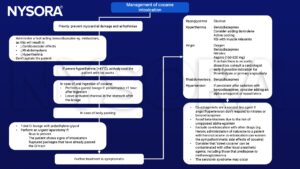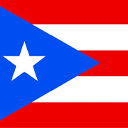Learning objectives
- Diagnose and treat cocaine toxicity
Definition and mechanisms
- Cocaine intoxication refers to the subjective, desired and adverse effects of cocaine on the mind and behavior of users
- Cocaine has an indirect sympathomimetic effect
- It is often mixed with adulterants which can cause health problems on their own
- The drug was the first local anesthetic discovered
- Cocaine is available in two forms – the hydrochloride (white powder) and free-base (‘crack’ cocaine) made by combining the hydrochloride and an alkali
- Intranasal or intravenous administration results in rapid euphoria and a sensation of power and tirelessness
- In higher doses, agitation, insomnia, hallucinations, and seizures may occur
- These effects are mediated by an increase in catecholamines acting at central receptors, but peripheral effects of sympathetic stimulation (e.g. raised heart rate and blood pressure) are also prominent
- The main danger in an overdose are cardiovascular complications
- Levamisole is an anti-anthelmintic agent found in up to 70% of cocaine samples and can cause agranulocytosis and vasculitis
Signs and symptoms
| Cardiovascular | Tachycardia and hypertension Arrhythmia and cardiac conduction abnormalities Acute coronary syndromes: vasospastic and /or coronary thrombotic QT prolongation Aortic dissection |
| Neurological | Euphoria Anxiety, dysphoria, agitation, and aggression Paranoid psychosis Hyperthermia, rigidity and myoclonic movements Seizures Depression, sometimes with tentamen suicide |
| Respiratory | Pulmonary edema Pneumothorax Pneumomediastinum |
| Peripheral sympathomimetic | Hyperthermia Muscle fasciculations Mydriasis, sweating and tremor |
| Other | Hyperthermia induced rhabdomyolysis, renal failure, and cerebral edema Subarachnoid/intracerebral hemorrhage Ischemic colitis Ileus (body packers) Epistaxis |
Management

Suggested reading
- Kramers C. et al. Toxicologische behandel informatie: Cocaïne, 2020, accessed 25/01/2023, https://toxicologie.org/cocaine
- Nicholson Roberts, T., Thompson, J.P., 2013. Illegal substances in anaesthetic and intensive care practices. Continuing Education in Anaesthesia Critical Care & Pain 13, 42–46.
- Jenkins BJ. 2002. Drug abusers and anaesthesia, BJA CEPD Reviews. 2;1:15-19.
We would love to hear from you. If you should detect any errors, email us customerservice@nysora.com



